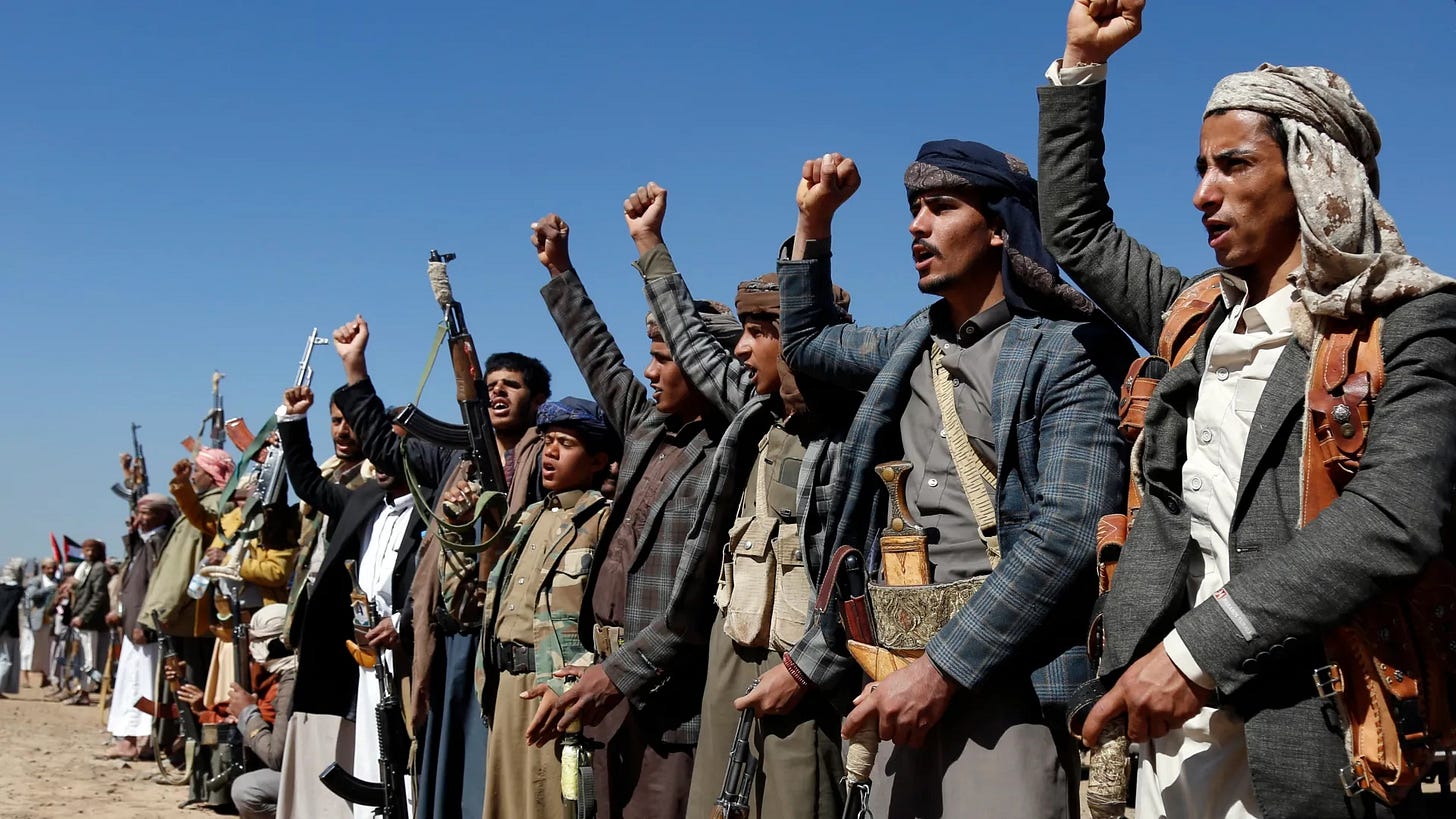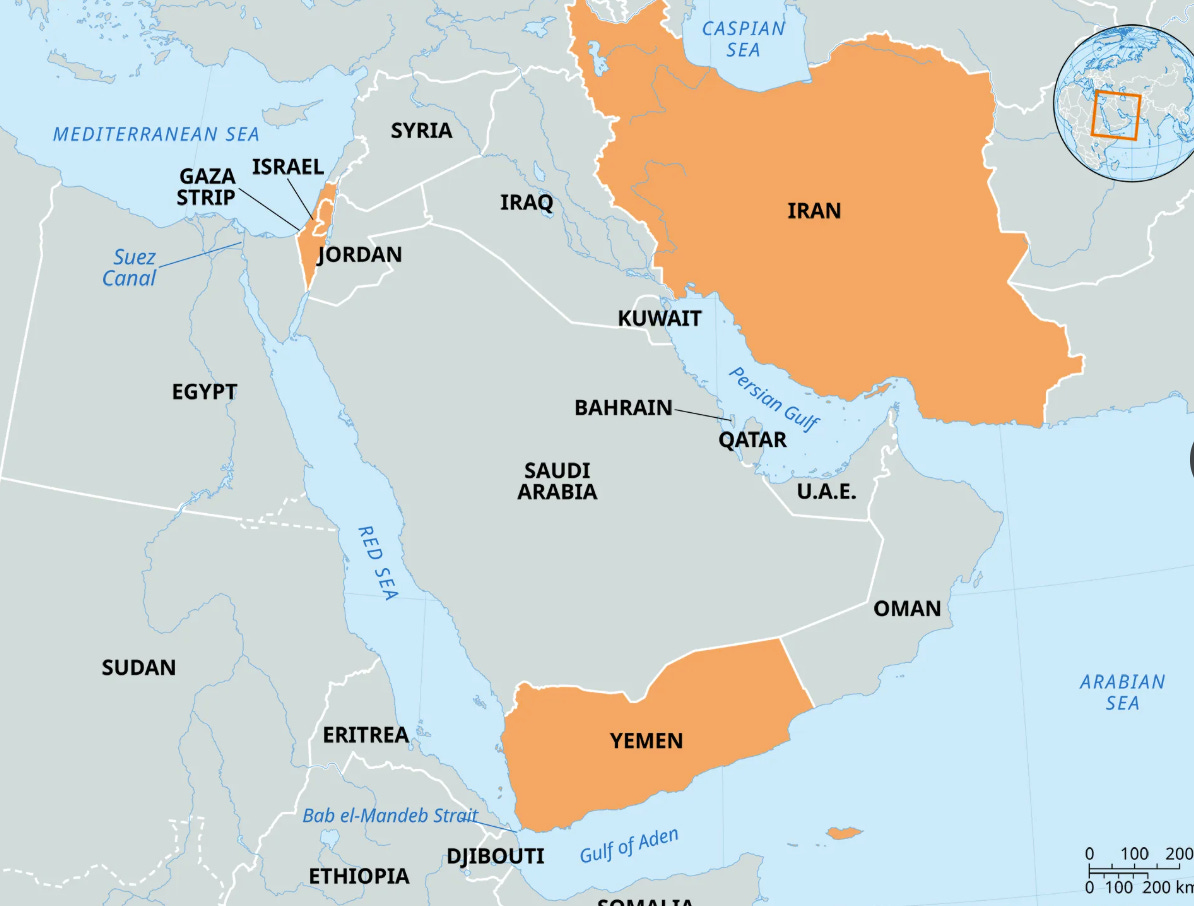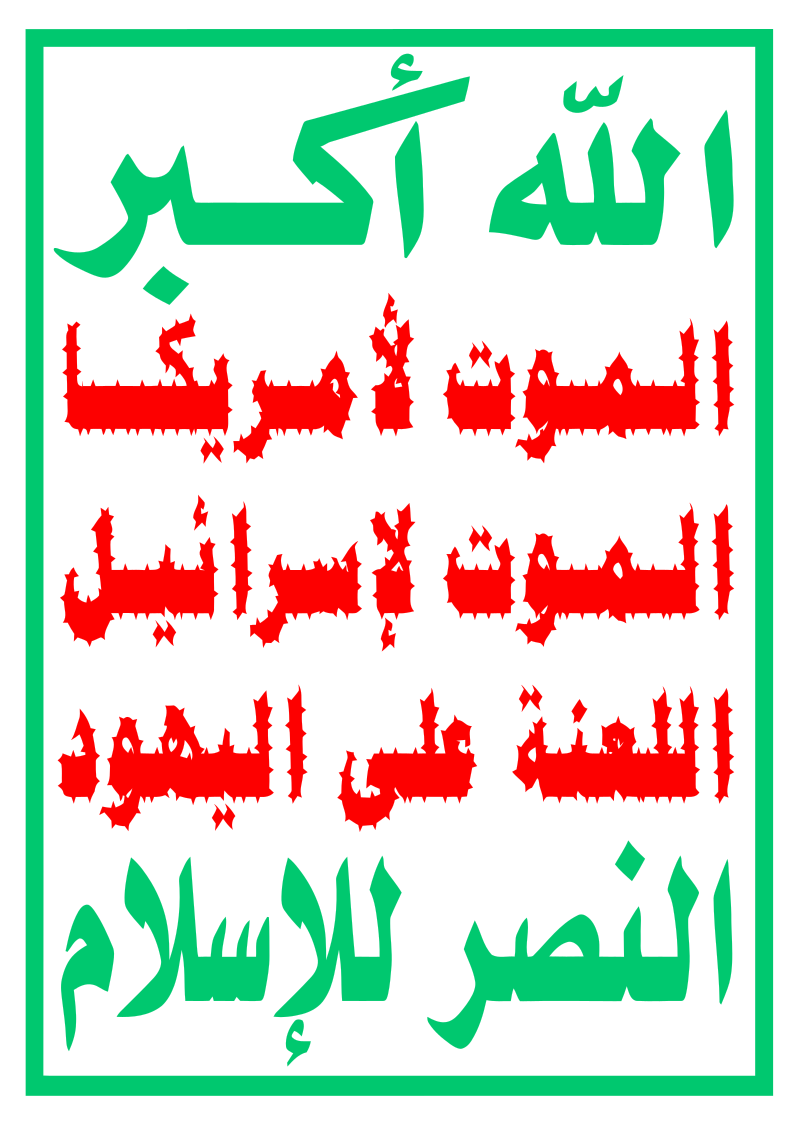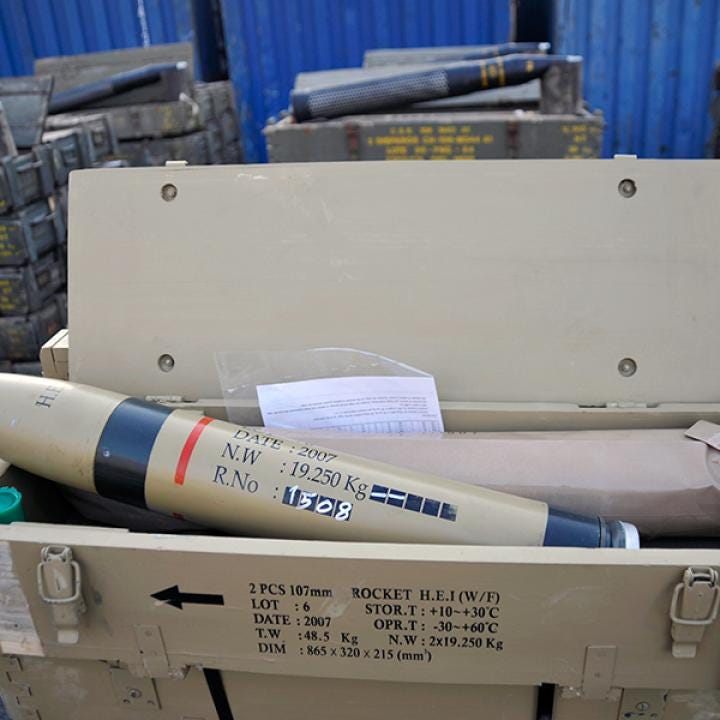The Houthis Create Havoc - How Might Israel Respond?
December 28 , 2024 - Issue #67
Thank you to all my subscribers and followers. You honor me with your presence. If you think this article of value, please share it with others. Please also consider indicating if you see value in the article by “liking” it or adding a comment. Doing so helps me determine the subject of future articles that you might find beneficial and, through social media, broadcasts my work to a wider audience.
In December 2023, two months after Hamas’ murderous invasion, I sat down in an upscale Tel Aviv coffeeshop with a former very high-level advisor to Prime Minister Netanyahu. Most of our discussion was about the ongoing war with Hamas and Hezbollah and what Israel’s strategy should be going forward. However, when we got around to the Houthis, he said that the United States needs to fight the Houthis, “this is their war, not mine.”
Now, a year later, that has changed.
It is Israel’s war too because…
Since October 2023, the Houthis have fired more than 200 missiles and 170 drones at Israel. Although Israel, the United States, and other international actors intercepted most of them, at least twenty-two struck inside the Jewish State. Since December 16, Houthis have launched seven missiles and five drones at Israel. By the time you read this, the count may be more. So far, the more noteworthy Houthi strikes were on:
December 19, 2024, when a missile aimed at Tel Aviv (or possibly Ben Gurion Airport) was intercepted over the skies of Israel. Shrapnel from the interception destroyed a school in a Tel Aviv suburb at 2:36 AM. If this incident would have occurred during the day, dozens of children would have been killed.
December 21, 2024, another missile, this time reportedly carrying an Iranian supplied maneuverable warhead, evaded Israel’s missile defenses before landing in a park in Jaffa. Fortunately, only sixteen people were lightly wounded.
On December 24, the IDF intercepted yet another Houthi missile. Twenty people required treatment for physical injuries or anxiety incurred while seeking shelter, including a sixty-year-old with a serious head injury.
December 27, 2024, the U.S. THAAD interceptor system that America deployed in Israel chalked up its first kill, destroying an incoming Houthi missile.
On each of these occasions, and all the other times in the past that Houthi missiles have flown inbound towards Tel Aviv, alarms sounded, causing millions to interrupt their daily lives or nightly sleeps to urgently seek shelter. It is an intolerable situation that no nation would accept. Especially because if the attacks continue it is only a matter of time before a missile strike kills many Israelis. And the Houthis show no signs of stopping. What was once periodic is now daily.
Nor is the current situation tolerable for the international community. Since October 7, Houthi UAVs, missiles, and explosive boats have launched at least 238 attacks against shipping in the Red Sea area, some involving multiple strikes. In addition, on November 19, 2023, Houthis hijacked a British vessel and took its 25-man crew hostage. They are still in Houthi hands. Houthi targets are not just ships connected to Israel. They target much of the shipping in the region—focusing now on anything related to Israel, the United States, or Britain, including ships of other nations carrying cargo to ports of call in those target countries (but in truth Houthi criterion for excluding targets seems very loose or almost nonexistent). In addition, the Houthis have gone after, so far without success, an American aircraft carrier and other warships.
Due to Houthi action over the last fifteen months, less than half of the cargo ships that once plied through the Red Sea do so today. War insurance costs have more than doubled and most container ships avoid the region through which 10-15% of the world’s shipping once travelled. As a result, the cost of transporting goods has rocketed upwards due to the need of shippers to use an alternate route around Africa that takes much longer resulting in a multitude of added expenses. This, according to J.P. Morgan Bank, could have a measurable impact on worldwide inflation that might approach an extra 750 billion dollars of costs worldwide to consumers (seven tenths of 1% of a global GDP that is more than 100 trillion dollars).
This is serious and it demands a forceful response that will put an end to Houthi aggression. But before I summarize what Israelis and the western world’s response has been to date and what Israel might consider in the future, let me answer the following question…
Who Are The Houthis?
Officially known as Ansar Allah, the Houthis are a Zaydi Shiite movement (Zaydi Shiites have slightly divergent views from mainstream Shiites) that arose in the mountains of impoverished Yemen in the 1990’s. Supported by Iran, and trained by both Hezbollah and Iranian operatives, the Houthis grew in numbers and power to the point that it now has both strength of arms and technical knowhow. Concordant with their growth was a longstanding mutual enmity between the Houthis and Saudi Arabia. In 2009 a small number of Houthis took control of a small portion of Saudi territory before being evicted. Then, in 2014, after the Houthis took control of Saana, Yemen’s capitol, and threw out Yemen’s government, Saudi Arabia, grew alarmed by the growth of this radical organization on its southern border that Iran nurtures. Therefore, Saudi Arabia, in conjunction with several other Muslim countries, initiated a war with the Houthis in 2015 designed to restore Yemen’s prior regime to power. By 2019, a stalemate developed, in 2021 the United States announced it would no longer support Saudi offensive operations in Yemen, and by 2022 the war fizzled out, leaving a negotiated cold peace in its place—but not before 150,000 Yemenites died due to the fighting and more than 200,000 lost their lives due to starvation and poor healthcare. Today, the Houthis control northern Yemen, which is about 1/3 of Yemen’s land mass, and the majority of Yemen’s thirty-four million people. Whether or not Houthi controlled Yemen is now a Houthi state is up for debate, but the Houthis certainly are a terrorist army.
And, as is so often the case, the Houthis since their inception have hated someone else too—the Jews. The Houthi flag consists mainly of a slogan, “Allah is great, death to the USA, death to Israel, curse the Jews, victory to Islam.”
After Hamas invaded Israel, the Iranians activated their Axis of Resistance that included the Houthis. Now, with Hamas, Hezbollah, and Syria much out of the picture, the Houthis remain as the last standing powerful-member of Iran’s evil axis. Thus, it comes as no surprise that the Houthis state that they will not stop firing at Israel until the war in Gaza ends. Nor is it surprising that since Hezbollah agreed to a ceasefire and a withdrawal and Syria fell that the Houthis have stepped up their game. Whether this is of their volition, or Iran’s instigation, or both, remains unclear. But their hatred of Jews is clear. And that hatred has existed since well before October 7, 2023. Preaching at a school in January 2002, the then leader of the Houthis said that the Houthis had the “great honor” of being the first to speak a chant spreading “wrath” against America, Israel, and Jews. He noted he had included the Jews “because they are the ones who move this world, who spread corruption in this world.” Also, a UN commissioned report “documented the systematic persecution of Jews in Houthi-controlled areas.” Therefore, nobody should be hopeful that the Houthi thorn in Israel’s side will soon go away at its volition.
What Is The International Community Doing?
On Dec 21, U.S. warplanes struck Houthi missile storage and command facilities in Sanaa. In October and November as well, U.S. warplanes attacked other Houthi targets to stem Houthi aggression. In fact, the U.S. has launched numerous other strikes against the Houthis in the past year, all supported by UN Security Council Resolution 2722 that condemned the Houthi attacks and affirmed member state rights to defend their ships. The Resolution also demanded that the Houthis immediately release the ship and crew it captured in 2023. Of course, the Houthis have ignored the resolution. They also have not been deterred by the multilateral naval task force the United States created in December 2023 (codenamed Operation Prosperity Garden) to protect vessels in the region.
What Has Israel Done About The Houthis?
On December 26, at least twenty-five Israel warplanes stuck Houthi related targets in Yemen’s capitol city (Saana), Yemen’s international airport, and at ports and other locations around the country. It appears the targets, for the most part, consisted of infrastructure used to facilitate Iranian weapon shipments to the Houthis. Ironically, Israel’s Dec 26 retribution began while the Houthi leader was delivering a speech on TV. It was the fourth Israeli attack since the Houthis started firing at Israel. Netanyahu also issued the following statement, “We are determined to cut off this terror arm of the Iranian axis of evil. We will persist in this until we complete the job.”
Several days earlier, after the Houthis fired the missile on December 19 at Israel, at least fourteen Israeli jets struck multiple targets including eight special tugboats used to pull ships into ports. And previously, once during the summer and once in the fall, Israeli jets struck Houthi targets in Yemen.
But so far, the Houthis keep firing. Something more needs to be done.
How Might Israel Deal With The Houthi Threat
Israel’s first problem is that Yemen is a long way away. Planes flying from Israel to Yemen must travel 1,200 miles each way—more than their combat range--thus necessitating use of Israel’s fourteen outdated tankers, of which it is only certain that seven have the capability to refuel Israel’s best warplanes, its F-35 fighters. Given that only two planes can refuel at a time on a tanker, and there is a limit as to how much fuel the tankers can carry, this significantly limits the number of warplanes that can attack at any one time. Furthermore, the Houthis gained much experience fighting and hiding from the Saudis in their dug in positions and tunnels in the mountains. Thus, it is difficult for Israel to make a decisive impact on Houthi missile delivery capability. Even more so because from those locations, the Houthis can fire rockets and drones quickly—way before Israeli fighters can arrive on scene to destroy them before they launch.
As a result, it appears both the Israelis and the Americans have focused on destroying:
Houthi missile and drone storage facilities; and
Iran’s delivery routes and the Houthis’ receiving infrastructure for Iranian weapons exports.
This starve the beast strategy sounds a lot like what Israel attempted in Syria during the War Between Wars period from as early as 2012 to 2023, during which best estimates are that Israel interdicted 70% of the weapons Iran sent to Hezbollah. But over the years, this still left Hezbollah with a lot of missiles. Thus, important as a War Between War strategy in Yemen may be to delay a massive Houthi buildup and resupply of weaponry, alone it is not enough because the Houthis need only fire one or two missiles a day to create turmoil in Israel. Such a strategy will fail even more so if the Houthis increase their present capability to construct missiles from smaller component parts that are much easier to smuggle into Yemen.
Another option would be to attempt to deter the Houthis by destroying Yemen’s economic infrastructures. But Yemen is already impoverished, and I doubt further starvation and economic woe would impress the Houthis or cause the populace to overthrow the Houthis, while it would certainly inflame the international world—not to mention give rise to real humanitarian concerns since the Houthis, like their Hamas and Hezbollah brethren, have no compunction about using their people as human shields.
Some commentators suggest a third path—building a global coalition that would include branding the Houthis worldwide as terrorists and also convincing the Saudis and the UAE to take them on, perhaps on the ground, in conjunction with Israel (who would likely mostly provide technical and airpower support). But, while this is a good idea in theory, I think it would:
Take too long to implement
Be too uncertain in its cohesiveness and effectiveness
Fall short because the coalition partners might have differing agendas such as freedom of the seas rather than Israel’s security.
Likely fail to form because a coalition that allocates casualty risks on the ground to some but not others is difficult to create.
That leaves, as I see it, two other options at present—assassination or leveraging Iran.
The Israeli assassination campaign that targeted Hezbollah’s leadership played a large role in reversing the course of the war. The same could happen if a multitude of Houthi leaders were dispatched. But Israel’s ability to deal Hezbollah’s leadership a decisive blow was built over years. Thinking that Israel could soon be equally effective from a standing start with the Houthis that are ten times farther away than Hezbollah is a pipedream (although Israel never ceases to surprise me with its intelligence acumen).
Therefore, I see only one path to victory over the Houthis and peace—regime change in Iran (previous newsletters have addressed this issue) or at a minimum, shrinking Iran’s ability to export mayhem through destroying its economy leaving Iran financially unable to support terrorism abroad. This might be done through peaceful means at first, but should be augmented by kinetic acts in a matter of days or weeks if diplomatic initiatives fail to show immediate promise (they likely will not). And such a policy should be announced loudly and repeated continuously. Threatening the Houthis is not enough even though Israel should. Nor is Israel continuing its bombing campaign in Yemen and instituting a Houthi leadership assassination campaign enough, even though Israel should. Iran must also feel the heat. Only Iran can put an immediate stop to the Houthi missile and ship interception campaign if Iran’s leadership is made to see that Houthi forbearance is in Iran’s self interest. Already, some Israeli commentators are exploring this option but the government has been quiet.
In short, Israel must turn off the flow of weapons to Jihadi extremist regimes at the spigot—Iran. To do that, everywhere it can, Israel must expose Iran’s perfidy and advocate for severe economic sanctions while maintaining maximum military pressure on the Houthis. Meanwhile, Israel and even better the world, must make clear that Iran’s supplying weapons to terrorist entities, like advancement of its nuclear program, will not be tolerated in any instance. And that if Iran does so “all options are not on the table” but rather, that all options will be used immediately. Then, either Iran will either pull back on their Houthi bit out of fear of what otherwise will come, or Iran will lose the capability to support its Axis of Resistance. This is the only path forward for Israel to stop the Houthis—by choking the flow of weapons to them.
Also, if you have an interest in the danger Hezbollah presents and how it came to be, you might consider purchasing my book which can be obtained on Amazon here.
Questionable Counting: Analysing the Death Toll from the Hamas-Run Ministry of Health in Gaza—Written by Andrew Fox for the Centre for New Middle East—December 2024
A New Era of Hezbollah Defeat—Written by Jonathan Schanzer and David Daoud for Commentary—December 18, 2024
Israel’s Strategic Options regarding Iran—Written by Yaakov Lappin for the Jerusalem Strategic Tribune—Dec. 2024
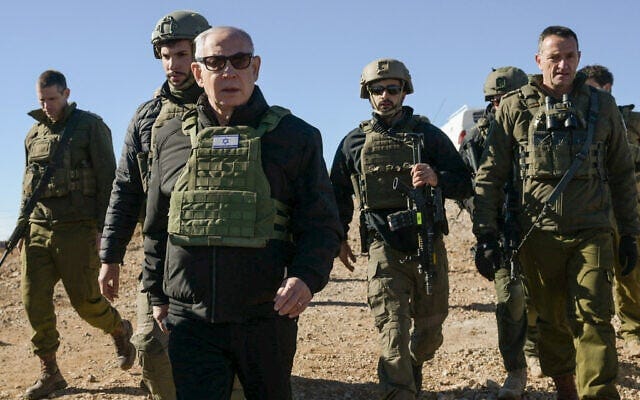
Atop Syrian Hermon, Netanyahu Says Israel to Stay Until ‘Another Arrangement’ Found—Written by Emanuel Fabian and others for the Times of Israel—December 17, 2024
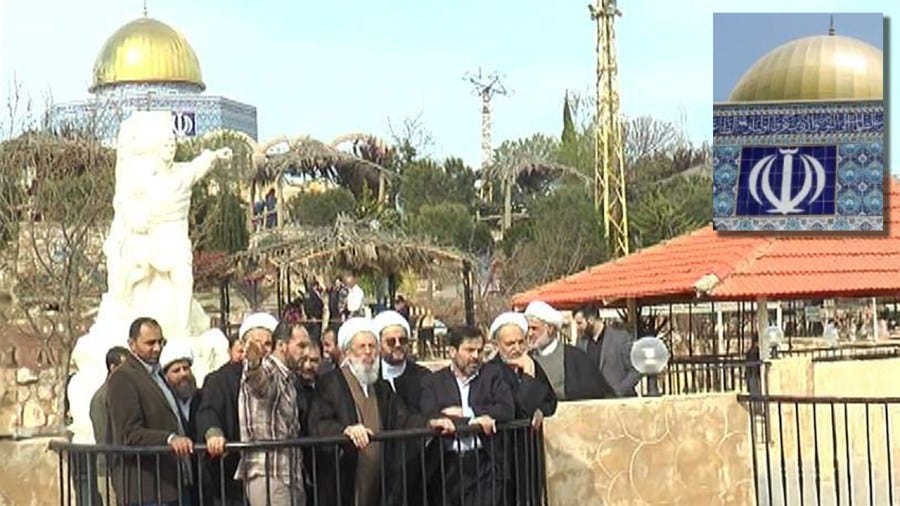
Iran Just Lost Its Last Colonial Settlement in Southern Lebanon—Written by Lenny Ben-David for the Jerusalem Center for Security and Foreign Affairs—December 16, 2024
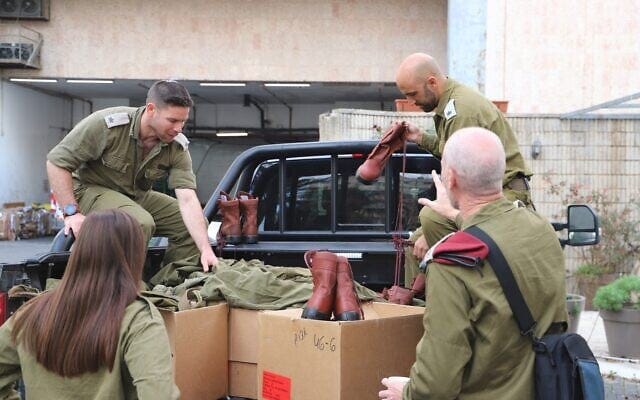
IDF Announces New Light Infantry Division Based on Volunteer Reservists—Written by Emanuel Fabian for the Times of Israel—December 17, 2024
Don’t Assume Iran’s Supply Lines to Hezbollah Are Cut—Written by Michael Knights for the Washington Institute for Near East Policy—December 12, 2024
Meta Dismantles Iranian and Hezbollah Influence Operations Targeting Israel—Written by Ari Ben Am for The Foundation for Defense of Democracies—December 18, 2024
IDF Introduces New Security Measures to Protect Gaza Aid Trucks—Written by Yaakov Lappin for Jewish News Syndicate—December 22, 2024
Israel’s Struggle with Hezbollah—A War Without End is now available in eBook and hardback format on Amazon and IngramSpark. This compelling narrative explores Hezbollah’s origins and cancerous growth, traces Israel’s response, and reveals Israel’s present readiness to meet Hezbollah’s challenge.
Cliff Sobin
Important Link—Alma Research and Education Center: Understanding the Security Challenges on Israel’s Northern Border


